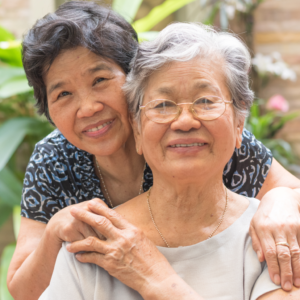Family Caregivers: An Unsung Force
by Megan Owens, ISR Aging & Disability Resources Specialist
You may have heard the terms “Graying of America” or “Elder Boom” to describe our country’s aging demographic shift. Or perhaps you’ve read an article about the so-called “Silver Tsunami.” One group of Americans is handling this seismic shift in society in their everyday lives, and they are the informal or family caregivers. It’s estimated that unpaid caregivers each year provide roughly 470 billion dollars worth of services – three times that of Medicaid spending for long-term care services in 2017 (AARP, 2019). Given that November is National Family Caregiver Month, it is time to shine a much-needed spotlight on unpaid caregivers, highlighting their efforts, be it triumphs or challenges, and raising awareness of the growing support needs.
An informal caregiver is anyone who provides care to an individual on an ongoing basis, without monetary reimbursement, typically helping with activities of daily living for an older adult or a person with a disability or chronic illness. According to the National Alliance for Caregiving and AARP (2020), most of this group consists of women (61%), and many fit in the “sandwich generation” (those who are caring for both their parents and their children). Learning new skills and tactics “on the go” is common for family caregivers to be able to adapt to changing care needs.
The ability to age in place is often the primary goal for most older adults; increasing support in the home is usually taken on by the family caregiver. No matter the long-term goal or the current care plan, multiple factors help to determine the outcome. Getting information on community resources through an aging and disability resource specialist at Island Senior Resources, coupled with a caregiver’s creativity and perhaps a dash of tenacity, makes for a good foundation. However, weaving together available community resources can still be a daunting task. Although caregiver burnout is very real, family caregivers may also benefit from the care experience through the opening of new social connections, learning a new skill, or feeling useful by fulfilling a need for a loved one, such as setting up Meals on Wheels deliveries or trying a new care approach for a person with dementia.
Caregiving is an essential public health service and should be more widely acknowledged and supported. There are approximately 9.5 million more family caregivers today than in 2015, bringing the total number to 53 million in 2020 (NAC & AARP, 2020). As an aging society and caring majority, we can come together as a community and harness the power of the Elder Boom era. As demand for community resources increases, so too must the volume of our collective voice in demanding more significant investments in caregiver support; not unlike your local library that will make a book available if enough patrons request it, simply making the request sends a strong signal. Family caregivers are the canary in the coal mine; it starts with you.
Asking for help is not always easy, but I’m here to tell you that it’s happening every day, and it’s never too late; let curiosity in, and if you don’t get the answer you need, maintain your curiosity and keep asking. Focus on what you as a care provider can reasonably accomplish and know your limits. Join a support group, get connected in whatever way possible to stay informed on the resources around you – support each other.
Providing a successful aging experience while maintaining other responsibilities, including time off to prevent burnout, can be challenging. Family caregivers have no shortage of compassion; caring is the most important part of care work, everything else can be learned. That is where we at Island Senior Resources can help provide necessary information and resources to the growing older population and their caregivers to remain in their own homes and environment as the aging journey continues.
References
AARP. (2017). [Infographic of family caregiver statistics for 2017]. Valuing the Invaluable: Understanding the Contributions of Family Caregivers.https://press.aarp.org/2019-11-14-Valuing-the-Invaluable-Series
The National Alliance for Caregiving (NAC) and AARP. (2020). [Infographic of a trended research series regarding caregiving trends over five years]. Caregiving in the US 2020. https://www.caregiving.org/research/caregiving-in-the-us/caregiving-in-the-us-2020/

